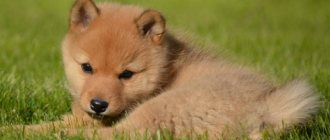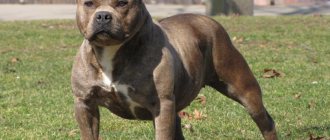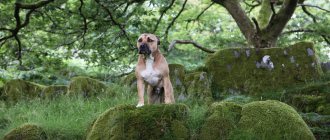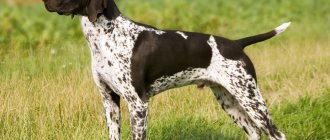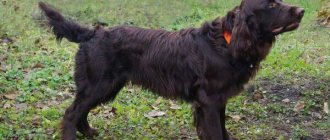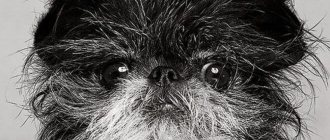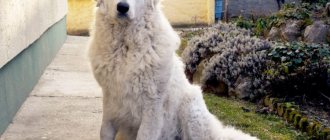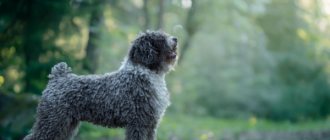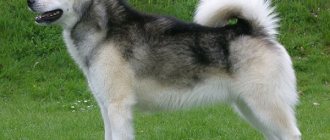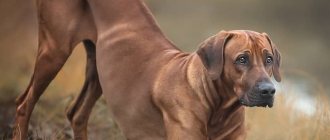Video
* We invite you to watch a video about the Pharaoh Hound . In fact, in front of you is a playlist in which you can select and watch any of 20 videos about a given dog breed by simply clicking on the button in the upper right corner of the window. In addition, the material contains quite a lot of photos. By looking at them you can find out what the Pharaoh Hound looks like.
In this article:
|
Rate the material!
[Total votes: 1 Average: 5]
The Pharaoh Hound is a rather rare and very expensive breed, one of the elite, and the history of its origin is shrouded in mystery. An elegant animal is a sign of true luxury, belonging to the highest circles of society. Pharaoh dogs are loyal to their owner, distinguished by their grace, and are recognized not only as excellent hunters, but also as reliable companions.
Attitude towards children and pets
Pharaoh hounds are very affectionate with children. Always supervise any interactions between dogs and small children. Teach your child never to approach any dog while it is sleeping or eating, or to try to take food from it. No dog should be left unattended with a child.
Pharaoh Hounds get along well with other dogs, but small dog breeds can give them prey drive—as can small pets like cats and rabbits. As with any breed, dogs of the same sex that have not been spayed or neutered may not be as tolerant of each other.
If you decide to get a dog, then get ready for the following: you will often have to clean up little mistakes after your puppy; investments will be required in annual vaccinations, feeding, toys, ammunition, etc.; any animal requires attention and communication, so if you don’t have time, then there will be no mutual understanding with a pharaoh hound puppy. Big changes are coming in your life. If you can handle this, you will find a loyal friend for life.
The history of the origin of pharaoh dogs
The first mention of a pharaoh's dog was found in the manuscripts of a member of the Order of Malta, which date back to 1647. Despite its name, the breed originated in Malta, but there is a version that the ancestors of these graceful animals accompanied the Egyptian pharaohs on the hunt. According to many scientists, the ancestors of the pharaoh dogs came to Malta along with the colonialists more than a thousand years ago.
There are many legends about pharaoh's dogs, one of which says that the deity descended to earth in the guise of a fire dog to save the human race and remained to live next to people. This graceful animal is often compared to the appearance of the god Anubis. The exclusivity lies in the fact that over many centuries of existence, the appearance of the dog has not changed at all.
Interesting fact: Until the 20th century, pharaoh dogs were known only in Malta and thanks to this they were able to maintain their authenticity. For many hundreds of years, they lived next to humans, participated in hunting small game, and guarded homes. Only in the 1960s the dog was brought to Europe and very quickly became world famous.
The first exhibition featuring a Pharaoh Hound took place in England in 1963. The breed was officially recognized only in 1977, in the same year its standards were developed and approved, and selection began. At the moment, the Pharaoh Hound is most popular in the United States, where the majority of nurseries and breeders of this breed are located. This animal is the pride of Malta. There are only about 5,000 thousand representatives of the ancient breed in the world.
Description and characteristics of the breed
The Pharaoh Hound is one of the oldest breeds in the world
The favorite of the Egyptian rulers belongs to the group of primitive (primary) dogs. This means that the original qualities and appearance of the animal have been preserved to this day, without changing through the process of natural selection. Thus, dog breeders value “pharaohs” for their grace, proud disposition and nobility inherent in aristocratic breeds.
Origin story
The history of the breed dates back a thousand years
Surprisingly, the homeland of the Pharaoh Hound is located far from the majestic pyramids. Despite the fact that these pets were depicted on the sarcophagi of Egyptian rulers, were present in manuscripts and on figurines, the breed originated in Malta. Local residents named it Kelb tal-Fenek, which translated means “hunting dog.”
This is interesting! There is a legend that the Pharaoh's dog was a “fiery essence” that descended from the star Sirius in the constellation Canis Major to save the Atlanteans. Ancient civilizations left many references to this deity. The Egyptians called him Inpu-Sab, the Atlanteans called him Akhnatui, and the Greeks called him Anubis.
Exactly when and how the pets got to Malta remains a mystery. Scientists suggest that dogs were brought to the island a thousand years BC. However, the first documentary mention of this breed, made by a member of the Order of Malta, dates back to 1647. Interestingly, at that time there were no other dogs living in the territory, so the gene pool only became stronger through the process of natural selection.
In the 30s of the last century, the first representatives of the breed came to England, where they took part in an exhibition. Experts and ordinary amateurs immediately appreciated the dog’s appearance, which provoked a massive export of animals from the island part. A few years later, in 1974, the breed was officially recognized by dog handlers in Great Britain. The surprising discovery was that the "pharaohs" did not need to be changed . The gene pool, formed over millennia, was passed on to future generations with virtually no flaws.
However, experts encountered a problem during the approval of breed standards, which took place in 1977. The difficulty was that at that time the Pharaoh Hound, originally from Ibiza, had already been registered. Since two breeds with the same name cannot be included in the FCI classifier, the first one was renamed and the Ibizan Greyhound. Thus, the four-legged animals from the island of Malta received their official name. However, from here one of the misconceptions of inexperienced dog breeders has spread that the Ibizan Hound is the Pharaoh Hound, given the external similarity of both breeds .
Ibizan Greyhounds resemble the Pharaoh Hound, but are not of this breed
The recognition of this subspecies by the US Kennel Club occurred relatively recently - in 1983. For several years, dogs were listed in the mixed category, taking part in exhibitions without titles. However, after the official registration of the “pharaohs”, their population began to grow. Today the USA is the leader in the number of breeding nurseries.
Important! The Pharaoh Hound is officially recognized by the FCI, UKC, SKS, AKC, KCGB, ANKC.
At the moment, these pets remain rare in Russia. The small number has a well-founded reason - the high cost of puppies. On average, a small four-legged “pharaoh” costs owners from 2.5 to 5 thousand dollars.
Video: breed overview
Standard
The Pharaoh Hound is an elegant, but quite powerful and strong animal.
Pharaoh hounds are relatively flexible, powerful and athletic animals. The height of males is up to 63 cm, females - up to 55 cm, and weight is 27 and 18 kg, respectively. Externally, representatives of the breed are distinguished by elegance, grace and slenderness.
The head is narrow, graceful in shape with sharp, erect ears. Their internal color, as well as the rim of the eyes and nose, is combined with the main color of the coat. The neck is muscular and slightly arched. The eyes are oval with an amber color. The chest is wide, the body is slightly elongated. The limbs of the “pharaohs” are quite strong and strong, sinewy, and long. Shoulders are well laid back. Elbows pressed to the chest. The hindquarters are set behind the outer line of the body with long thighs and pronounced muscularity. The hock joints are strong, like all greyhounds. The paws are collected, powerful with hard pads. The tail is straight, long, and hangs freely. It rises when the dog moves or is excited.
There is no undercoat, while the guard hair is very short and stiff. The length of the coat is uniform, with the exception of the ears and muzzle (a little shorter there). The acceptable color according to the standard is fiery (from red to brown). It is undesirable for a dog to have a mark on its face, a white star on its chest, or spots on its tail. Markings and fawn shades are allowed. White color on the nape or sides is considered a fault for which the dog is disqualified.
This is interesting! A unique feature of the breed is the change in pigmentation of the nose to a bright pink color at moments of emotional arousal of the dog.
Character traits
Becoming the owner of a Pharaoh Hound is a great honor, especially for show fans. These pets cannot help but attract attention. Strong, graceful, fast, with excellent sense of smell and vision, “pharaohs” instantly attract the attention of others. However, this breed is not for everyone. Dogs have an extraordinary mind and require a special approach and understanding.
Pharaoh dogs do not tolerate loneliness and confined spaces well. Born hunters, they cannot imagine life without running. Therefore, the breed is suitable for lovers of active recreation, and not for couch potatoes. The owners of such a dog will have to work with their pet for several hours a day, taming the ardor during busy walks.
Important! The breed is definitely not suitable for residents of northern regions, since the animal does not tolerate cold.
These four-legged dogs get along well with other animals in the house, as well as with children. However, they can be extremely sensitive, taking on people's emotions. These dogs begin to be socialized very early, trying to introduce them to a large number of people and situations. Otherwise, they grow up timid.
Video: Pharaoh Hound communicating with other pets
The disadvantages of the Pharaoh Hound include barking . The piercing sound helps the animal warn its owner of danger and becomes useful in hunting. However, if you leave your pet alone, he may start singing serenades, which will not delight the neighbors. This problem can be solved if there is a companion in the house or if you organize some kind of entertainment for your pet.
This breed also has a flaw called coprophagia - eating feces. The fact is that for many centuries the dog lived in the wild and had to hide traces of its presence so as not to get caught by a predator. Unfortunately, the strong gene pool has preserved not only the good qualities of the breed, but also such features of its behavior. Therefore, owners will have to immediately clean up their pet's excrement to avoid coprophagia becoming a habit that is almost impossible to get rid of.
Pharaoh Hound - description of the breed
The Pharaoh Hound is a primitive breed. For more than a thousand years, its representatives interbred only with each other. This is a beautiful animal with a rather elongated body, whose sexual characteristics are clearly pronounced. Males are always stockier and more powerful. Their height can reach 57-60 cm and weigh 20-28 kg. Females have less weight and height, which rarely exceeds 53 cm.
Breed standard:
- Lean but sculpted body;
- The dog's shoulders are tilted back and the shoulder blades are slightly retracted;
- The head is wedge-shaped with an indistinct transition from the muzzle to the forehead;
- Large cone-shaped ears that are set high;
- Strong jaws with pronounced cheekbones;
- The muzzle is elongated and narrowed towards the nose;
- The chest is voluminous;
- The neck is strong, rather high, and has a graceful curve;
- Almond-shaped eyes are located far from each other, set shallowly;
- The limbs are muscular and strong, but rather thin and graceful;
- The tail is thin, whip-shaped.
In adult animals, the iris of the eyes has a bright amber color, but puppies are always born with blue eyes. The color of the nose can change depending on the emotional state of the dog. When excited, it turns bright pink. This is quite natural and is not a flaw or deviation from the current breed standard.
The bark of pharaoh dogs is very piercing and loud, which is very helpful during a hunt or when a dangerous situation arises for the owner, but in normal circumstances it can be inconvenient. If a dog is left alone for a long time and not occupied with any activity, then it will alarm all the neighbors with its serenades and howls.
Breed standard
The Pharaoh Hound breed is medium in weight and height. With her entire appearance she radiates lightness and strength. Also, its representatives are characterized by endurance, grace and aristocratic elegance. The height at the withers of an adult female is 52-56 cm, and that of a male is 55-62 cm. The body weight of the first is up to 18 kg, and of the second – up to 25 kg.
The physique of the “pharaohs” is proportional and very muscular. The animal has a flat and elongated back. The chest is well expressed. It is narrow, but sticks out a little forward. The abdomen is noticeably sunken. The skin fits the body very tightly. According to the standard, ribs should be visible on the sides of the dog.
He has long and thin legs, the hind legs are stronger. The hind limbs have strong muscles that allow you to quickly push off and increase speed. The dog's legs are placed symmetrically. The Pharaoh Hound in the photo is slender, fit and graceful. In her movement there is a clear feeling of lightness and lack of haste. She walks smoothly and runs gracefully. This is a very flexible and agile animal!
Long thin tail with a high waist. Hangs down. According to the standard, it is not docked. This part of the body does not prevent the dog from hunting at all; on the contrary, it helps to maneuver. His neck is long and thin. The head is small. One of the most prominent parts of the “Pharaoh’s” body is his ears.
They are large, stand high on the top of the head, pointed at the tips. The shape of the ears is triangular. When a dog is surprised or concentrated, they rise higher. It's interesting to watch her ears move. The dog has a noticeably elongated muzzle, at the edge of which there is a large nose. Most often it is pigmented in the same color as the coat.
The setting of small eyes is deep. According to the standard, they should have a rich amber hue. These dogs have short hair. She is bright and shiny. It must shimmer in the light. If you do not see clear highlights on the Pharaoh Hound’s body, especially when the sun’s rays hit it, rest assured that it is not purebred.
The colors of the dog, in most cases, range from reddish to brown tones. It can have a rich red, light red, bright brown tint. Another common color among pharaoh dogs is melted chocolate.
Important ! It is preferable to have a small light mark on the pharaoh's chest and face. It is also not considered a deviation from the standard if there is a white spot on its nose or tail.
Popular colors of pharaoh hounds
The pharaoh's dog is characterized by a smooth and rather thick coat without undercoat. Short hairs are very soft, silky and shiny. The length of the coat is uniform throughout the body, with the exception of the muzzle and ears, where it is always slightly shorter. The standard allows for the fiery color of pharaoh hounds, which can vary from red to rich brown. The color should be bright and rich.
Marks on the muzzle, white marks on the chest, fingers, and head are undesirable, but they are not considered a defect. Fawn shades and light markings on the tail are allowed. White color on the sides and nape is considered a serious flaw, which can lead to the complete disqualification of the dog.
Interesting fact: Due to the lack of undercoat, Pharaoh Hounds do not tolerate cold well, so they are not suitable for breeders in northern latitudes with long and harsh winters.
If the winter is quite warm, then it is possible to use special clothing for dogs in the form of overalls, which must be used from late October to April. In rainy weather, you should use a raincoat, as your pet can easily catch a cold. Such a dog should live exclusively in an apartment or house; keeping it on the street is completely excluded.
Their short hair is almost not subject to shedding, and the animal does not have a characteristic “dog” smell, which is an undoubted advantage of the breed. There is no need to comb the dog, just walk it with a hard glove once a week. They are also washed rarely - once or twice a year and always without using detergents.
What do you need to know when choosing a Pharaoh Hound puppy?
It is advisable to choose a puppy from a breeding kennel with a good reputation
This question is very relevant. Pharaoh Hound puppies are expensive, prices from different breeders are almost the same, but the quality, unfortunately, is not. When purchasing a dog, you want to have a beautiful, standard, healthy animal with a good nervous system. So how do you make the right choice?
You can pick up a “Pharaoh” puppy at 1.5–2 months, but it is important to pay attention to the following aspects:
- He must be well-fed, active when awake, and also have a good appetite.
- A healthy puppy has strong bones and straight limbs. Thickening in the joint area is acceptable - these are the so-called “growth zones”.
- Examine the baby's appearance. The coat should be smooth, dense and shiny. The tail is straight and long, without kinks or curvatures.
Thin skin through which the ribs protrude, tousled dry hair, protruding maklaks, scabs are signs that indicate that it is better to refuse to purchase such an animal.
Inspect the place where the baby was born and lives. It should be kept in a clean, dry and well-ventilated area, without strong odors. In the puppy's behavior, evaluate how the animal reacts to the appearance of a new person. A healthy baby is friendly, not aggressive, does not press to the ground when raising his hand, and responds adequately to stroking.
Pharaoh Hound puppies are born with blue eyes. A yellowish tint appears after 2.5–3 months, which gradually turns into amber. Therefore, you should not be afraid that you are being offered a mongrel dog; this phenomenon is within normal limits. It is also quite natural that the ears of the little “pharaoh” have a hanging position. They stand up at about 3–4 months.
Important! Sometimes a dog's ears become erect by the age of 1 month. However, dog handlers know that this phenomenon is typical for puppies with excessively light bones. Such pets, as a rule, grow up a little narrow and poor-boned.
Always pay attention to the puppy's mother. If they show you an exhausted and tired bitch, and the breeder explains that she was “sucked” by the babies, this, alas, is deceit. Under normal conditions, a dog is fed quite well during pregnancy and lactation, so it gains weight rather than loses it. You should not risk buying a baby from a sick animal.
A conscientious breeder will also always provide a full package of documents for the pet: pedigrees of the parents, grades, exhibition titles and certificates, vaccination card. You shouldn’t refuse to study them and say that you don’t understand it. It is the responsibility of the breeder to explain every question that interests you. The seller is also required to provide documents for the puppy: a veterinary passport, which indicates age-appropriate deworming and vaccinations, a puppy card and recommendations for caring for the baby.
Character and habits of pharaoh dogs
Pharaoh's dogs, despite their impressive appearance and strength, are very gentle pets that are strongly attached to their owner. They do not single out any of their household members and accept affection from everyone equally, but they never impose themselves.
The dog is distrustful of strangers and is always on guard in their presence. Earning their trust is very difficult if they have not known the person since early childhood. The Pharaoh Hound does not show aggression unless there are serious reasons for it.
The animal treats pets rather condescendingly without showing any warm feelings. A dog can safely live under the same roof with a cat, small rodents, and other dogs. If a dog is on the street and encounters a strange cat, his hunting instincts may awaken and he will rush after her, despite the owner’s protests. With other dogs the pet behaves with dignity, but in a friendly manner. In case of a threat, he is always ready to attack and speak out in defense of his household.
Interesting fact: Pharaoh's dog is very patient with children, ready to tolerate their mischief and participate in games. If the attitude is too rude, he will simply walk away without retaliatory aggression.
Representatives of the breed always make decisions independently. If the owner's command is impractical from the pet's point of view, then it will be difficult to achieve. The use of moral pressure or physical violence is unacceptable. Boring and repetitive lessons quickly bore the dog, it becomes stubborn, and its attention wanders. It is necessary to organize games in such a way that the pet is interested in the process.
Character and temperament
This is a friendly breed that seems to delight in the world around them. Very smart and quick-witted. Sensitive to people's moods, she will never have fun if the owner is sad.
The Maltese Huntress is sensitive to its surroundings; when it is happy or excited, its nose and ears turn red .
The Pharaoh Hound has a gentle psyche , so the owner needs to start showing the puppy new places as early as possible so that he absorbs smells, sounds, and sees other people. If you do not socialize your pet, he will grow up nervous and will be sensitive to any changes.
Interesting fact: they say that you can only fool the Pharaoh Hound once, he will never fall for the same bait twice.
Interesting facts about pharaoh dogs
It is believed that pharaoh dogs originated from mixing the blood of the most ancient representatives of the wolf and jackal families. In Ancient Egypt they were worshiped as the incarnation of the god Anubis on earth.
According to many owners of these graceful dogs, they may be aware of their guilt and even embarrassed. At this moment, the tip of the dog’s muzzle and ears turn pink. When a pet is happy and in a good mood, its lips stretch into something like a smile.
Representatives of the ancient breed are very independent and their owner will always have to assert his authority so that the pet obeys him.
Due to the fact that for many centuries the Pharaoh Hound existed in the wild and it was forced to hide traces of its presence from predators, it is characterized by coprophagia, that is, eating its own feces. The pet owner will have to come to terms with this feature and try to immediately remove traces of its vital activity so that it does not become a habit.
For these dogs, a standard two-time walk every day is not enough. They need active running and energy-consuming games several times a day.
If the dog is left alone in the apartment, he will immediately begin to howl loudly. The reason for the howling is not the animal’s fear, but simple boredom.
This breed has a unique hunting technique in which the dog jumps over the hole where the prey is hiding, and then lands on all fours. The victim leaves his shelter, and the dog immediately rushes in pursuit of him.
Pharaoh dog diseases, symptoms and treatment
One of the healthy primitive breeds , as it has hardly been affected by commercial breeding. These are hunting dogs that have undergone natural selection. As a result, pharaoh dogs live quite a long time. Life expectancy is 11-14 years, which is quite long for a dog of this size. Moreover, it is not uncommon for them to live up to 16 years.
Main diseases:
- Sensitivity to anesthesia. Because this breed has little body fat, they are sensitive to anesthesia and require less dosage than a dog of the same weight of another breed. If your dog is undergoing surgery, make sure your veterinarian is aware of this breed characteristic.
- Allergy. The breed has three types of allergies: to food components, contact allergies (for example, to shampoos) and to various irritants in the air (pollen, dust).
Otherwise, this is a breed with good health; the main thing is to protect it from hypothermia and wear a sweater or jacket even when the temperature drops slightly.
Pros and cons of pharaoh dogs
The character of pharaoh dogs is quite complex. Before purchasing one, you should pay attention to the advantages and disadvantages of the breed.
Pros of Pharaohs:
- Dogs are smart, they always think about every command;
- They are not characterized by aggression;
- The animal is very active, and during the game it easily learns various tricks;
- Representatives of the breed are distinguished by unsurpassed devotion to their owner, and all other members of the household are perceived as members of the pack who need to be protected;
- The Pharaoh Hound is not dangerous even for the smallest children, and is always patient;
- With timely socialization and correct upbringing, dogs treat other dogs calmly and will not be the first to rush into a fight;
- Pharaohs are wary of strangers, but without aggression and never let them out of their sight.
Among the disadvantages of the breed, it should be noted that it is excessively independent and has an overly shrill voice. A dog may refuse to obey its owner's command if it considers it inappropriate. An owner with such a pet should never relax, otherwise the dog will stop obeying him and show his wild nature in all its glory.
For some breeders, excessive dog activity will be a problem. An ordinary leisurely walk is not suitable for these animals. They love to jump, run, cover long distances, and participate in games.
Pets tolerate loneliness very poorly, yearning for their owner. If possible, it is better to take the dog with you or leave it in the care of household members who can devote a sufficient amount of personal time to it.
Appearance description
So what are these mysterious dogs supposed to look like?
- The Pharaoh Hound is not big. She can rather be classified as average. Weight ranges from 19-27 kg. Due to its sophistication and stunning posture, the pharaoh's dog often appears taller than it actually is. According to the standard, height should be between 53-64 cm.
- The head is elongated and wedge-shaped. The standard stipulates that it should rest on a thin, long neck. The ears are also elegant - pointed, always in a standing position. The transition from the forehead to the nose is smooth, without a pronounced “stop”. The small amber-colored eyes are oval in shape. The small nose has a red or flesh-colored color, but during periods of increased emotionality it turns red. Despite all the elegance, the pharaoh dog’s jaws are strong, forming a scissor bite. A rather rare nuance that is not found in any other dogs: the favorite of the pharaohs can stretch her lips into a smile.
- The standard calls for thinness and gracefulness, as I mentioned above. However, I would like to separately note that this dog should not be frail. She is wiry and muscular. The body is always tense, as if game is somewhere nearby. The chest can be called broad.
- The tail is thick at the base. However, according to the standard, it should gradually become thinner towards the end. The shape is not straight, but slightly curved - I would compare it to a sickle. As for the height of the tail, it is moderate.
- The coat is short and lies quite tightly to the body. And everywhere. The standard requires a smooth texture, sometimes hardness is allowed. As for the color, it should be reddish. The reddish color, by the way, is allowed in varying intensities: from chestnut to tan-like. The short pile is dyed evenly. However, such fieryness can be diluted. So, advantageously and without contradicting the standard, the fiery color is set off by white inclusions. Specks of a similar color appear on the tip of the tail, fingers, and chest. Moreover, I should note that a spot on the tail is not just desirable, but mandatory!
Breeding pharaoh dogs
Having decided to have a pharaoh, you need to take into account the peculiarities of his character. Even not all experienced breeders are able to cope with raising a wayward animal; it is necessary to win the respect of the pet and establish your role as a leader. If you lack experience, it is better to turn to a specialist for help.
Puppies need early socialization. During subsequent training, you should take into account the pet’s innate hunting instincts and its incredible energy. It is necessary to build training in the format of an interesting game so that the dog does not get bored and actively responds to commands.
Interesting fact: Pregnancy and childbirth in Pharaoh dogs usually proceed without complications. There are from 3 to 10 babies in a litter. Childbirth usually occurs on days 58-63.
From the second half of pregnancy, it is necessary to limit the female’s contacts with other dogs, reduce her physical activity, and exclude climbing stairs and jumping. During this period, the amount of food must be increased every week by 10 percent at the expense of proteins. Additionally, add vitamins to your diet.
Pharaohs are very heat-loving and should be kept in a house or other warm room. The place to sleep should be in a secluded place without drafts. You should definitely purchase special dog clothing for walking during the winter months. The place for resting and eating must be kept perfectly clean.
Considering the rarity of this breed and the correspondingly high cost of puppies, you should soberly assess your capabilities for correctly maintaining and raising a pet. Improper care and insufficient attention to the dog will negatively affect its health and, ultimately, can lead to early death.
Education and training
Training of these dogs should be based on natural instincts
If you want to have a Pharaoh Hound, you need to take into account the peculiarities of its character. Not all experienced dog breeders can cope with the authority characteristic of this breed. In addition, the “pharaohs” are measured, quick-witted and consider every order of their owner. If the given command seems meaningless to the pet, then he will not carry it out. The trainer must gain the dog's respect and establish himself in the role of leader gradually, without intrusiveness.
When training, you should take into account the animal’s innate energy and curiosity, relying on its instincts. Give commands as if it were part of a learning game and use exclusively positive motivation. By teaching your dog tricks, you will delicately explain who is in charge in the pair.
Important! Avoid monotony in raising and training your dog. Even repeating a command three times can make a four-legged animal lose interest in the process.
Representatives of this breed perfectly master basic commands, such as: “Near!”, “Fetch!”, “Lie down!”, “Give me a paw!” etc. But for them it is too banal and uninteresting. Give preference to more active training, using obstacle courses and performing difficult tricks. And if you are planning to contact a professional trainer, the “City Dog Course” would be quite appropriate, attracting and educating at the same time.
As mentioned earlier, pharaoh dogs are prone to such bad habits as eating excrement. Stop your pet at the first manifestation of such behavior, indicating the prohibition with a command.
Caring for Pharaoh Hounds
Short hair will not cause any inconvenience if brushed regularly. The molting of these animals goes almost unnoticed by household members. Sometimes, due to errors in nutrition, severe hair loss can occur, but this problem can be solved by introducing vitamins and microelements into the diet. Pharaohs are washed 1-2 times a year and be sure to thoroughly dry the wool. It is better not to use detergents at all or choose shampoos with the mildest composition.
You should always remember that even a slight minus can be dangerous for a pet, since it has practically no fat layer. Warm overalls are required. Pharaohs love to choose the master's sofa as a place to relax, as they do not tolerate hard surfaces well. You should provide your pet with a soft, warm bed.
The ears of pharaoh dogs are examined after each walk. Trapped debris and insects can trigger the development of an inflammatory process, so they should be cleaned regularly. The eyes are wiped every day with a soft cloth soaked in warm boiled water. Your pet's teeth should be brushed every 5-7 days with dog toothpaste and a silicone toothbrush for babies. It is useful to give your dog special cleaning bones that gently remove plaque. Claws are trimmed as needed.
Proper and timely care will help protect your pet from developing many dangerous diseases. You should carefully monitor the dog’s coat and promptly clean it of parasites. Pharaohs are taught all hygiene procedures from an early age.
Care and maintenance
The dog has very high mobility, so it cannot exist in a city apartment for a long time. A private house with adjacent territory would be ideal for her. Here the dog will be at ease, but you should take care of installing a reliable fence, since the dog can jump well.
Caring for a pet is not difficult. Not only does the dog have a short, dirt-repellent coat, but it is also clean and practically odorless. It makes sense to wipe the wool weekly with a damp sponge or a special terry mitten, and wash it in rare cases when it is off-season and dirty.
The means by which a dog purifies itself does not matter as is the case with some other breeds. You don’t have to buy a special shampoo, but get by with baby formula. Moreover, it is important that it must be added to the water, and not applied to the wool. The ears need to be cleaned once a week, and the nails need to be shortened.
Diet of pharaoh dogs
Pharaoh dogs usually gain muscle mass by the age of three, and before that, a sufficient amount of protein must be included in their diet. As a rule, dogs are not susceptible to food allergies and there are no problems with choosing food.
Adults are fed twice a day. Preferably prepared feed of the highest quality. If the dog is on a natural diet, then it must be balanced with the obligatory addition of vitamins and microelements. Calorie content should be compared with the physical activity of the pet and its age.
When using natural food, you must adhere to the following rules:
- Your pet's diet should include only lean meat, which is best scalded or frozen beforehand to prevent infection by parasites;
- The menu of a dog of any age should be designed in such a way as to fully satisfy the body’s needs for nutrients;
- Fermented milk products and chicken eggs in reasonable quantities are good for dogs;
- Smoked meats, sweets, flour and other harmful products are completely excluded;
- As a source of carbohydrates and fiber, it is useful to add various cereals, but not legumes;
- Be sure to accustom your pet to vegetables and herbs.
Pharaohs should not be overfed or given foods that cause excessive gas formation. Between meals, your pet should have time to get hungry. It is important to have free access to a bowl of clean water. All nutritional supplements should be introduced into the diet only after consultation with a veterinarian, since excess amounts of vitamins can be even more harmful than their deficiency.
Related breeds
Basenji
The Basenji is called the Congo Terrier, Nyam Nyam Terrier, Bush Dog and more. This is a compact animal that can become an excellent companion. In addition, the Basenji is the dream of many owners, as it has one unique feature - it does not bark.
Owners describe the breed as an amazing combination of independence and affection, obstinacy and complaisance, innate intelligence and childish recklessness. The complex nature of the Basenji requires careful attention to the pet, which will become a faithful friend only to a sensitive leader.
The developed pack instinct dictates certain behavior - to be nearby, to watch people. At the same time, they are emotionally restrained: crawling under one’s feet, squealing with delight, panicking alone, licking oneself, demanding affection is not typical for them.
On the other hand, if the level of trust is high enough, the Basenji sits on his knees at the first call, squinting with pleasure under the caressing hand. But close contact is allowed only to “insiders”, and from a stranger they will either simply move away or click their teeth in warning.
The ideal owner can be described as someone with some experience as a dog owner, physically active, and with plenty of free time. And also with a developed sense of humor, strong nerves and prepared in advance for the fact that the pet will not always obey.
Diseases and health problems
Pharaoh dogs can be called long-livers. The average lifespan of these beautiful animals is 14-18 years. An interesting fact is that pharaohs retain their activity and outstanding mental abilities until the end of their lives.
Dogs have very few health problems due to the strong breed gene pool, but hereditary pathologies are passed on to offspring more often.
Pharaohs may suffer from the following diseases:
- Intestinal volvulus due to weak muscles that support the organs of the digestive tract. This problem can only be solved with surgery;
- Dysplasia of the elbow and hip joints. With age, the situation worsens, the animal experiences severe pain during exercise;
- Puppies are sometimes diagnosed with congenital dislocation of the knee joint. A dog with this pathology can be injured again.
Pharaoh hounds do not tolerate various chemicals, fragrances in shampoos, tick killers, and so on. It is necessary to opt for gentle drugs with the most natural base possible. There may also be allergies to medications, so consultation with a veterinarian is required before using them.
Important fact: To prevent your pet from contracting dangerous infections, you must be vaccinated. Dogs of this breed tolerate this procedure easily, but only an absolutely healthy animal is vaccinated.
If the Pharaoh Hound has a balanced diet and a sufficient level of physical activity, then, as a rule, there are no additional health problems.
Breed standard and description
Male height at withers: 56-63.5 cm,
Height of the bitch at the withers: 53-61 cm
Weight: 18-27 kg
Color: bright red or reddish brown. There must be white marks, which are allowed in the following places:
- On the tail (highly desirable),
- On the chest (called a “star”),
- On the toes,
- A thin white stripe down the center of the muzzle,
- In other places, any marks are undesirable.
Additional characteristics: eyes amber, oval. The ears are set high and protruding, medium in size, very mobile. A distinctive feature of the dog is its pink nose, which matches the color of its fur. The dog's muzzle is similar to a fox: elongated, triangular in shape with a clear profile. The Pharaoh Hound has a toned body with a deep chest and slender, long legs.
